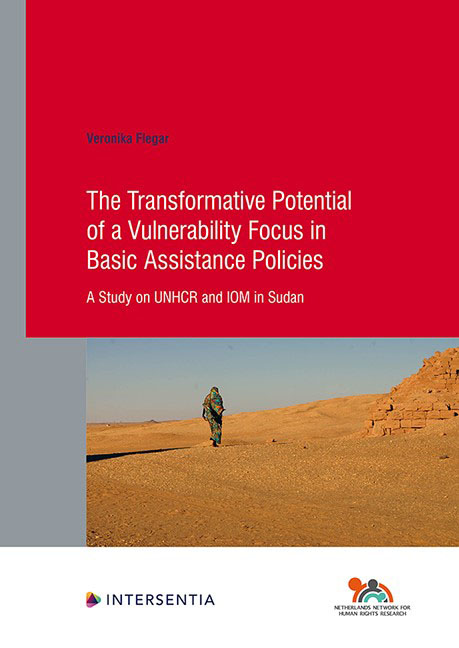 The Transformative Potential of a Vulnerability Focus in Basic Assistance Policies
The Transformative Potential of a Vulnerability Focus in Basic Assistance Policies Published online by Cambridge University Press: 11 November 2021
The present study sought to shed light on the complexities involved in assessing and addressing vulnerability in basic assistance policies at UNHCR and IOM in Khartoum, Sudan. In so doing, the study intended to critically reflect on the transformative potential of such a vulnerability focus for substantive equality and therefore for the realisation of universal human rights. This final chapter seeks to answer the study's overarching research question:
How can the vulnerability focus in basic assistance policies by UNHCR and IOM in Khartoum (Sudan) contribute to the vulnerability notion's alleged transformative potential for the realisation of universal human rights?
To do so, this chapter starts by summarising the extent to which the policy practices in the two case studies contribute to the vulnerability notion's alleged transformative potential (14.1). The chapter then elaborates upon the extent to which these findings might be relevant beyond the two case studies by reflecting upon the generalisability and conceptual limitations of the two case studies (14.2). With this in mind, but moving beyond the study's empirical findings, the chapter proposes some key characteristics of a normatively desirable and practically feasible way for providing basic assistance to non-citizens (14.3). Subsequently, the chapter highlights what the normative arguments in this study contribute to the debate on vulnerability in human rights theory (14.4). The chapter concludes with a short normative reflection on the human rights of noncitizens (14.5) and several policy and research recommendations on the basis of the empirical findings as well as normative-theoretical arguments (14.6).
NORMATIVE IDEAL AND POLICY PRACTICE
DESIRABILITY OF THE APPROACHES ADOPTED IN THE TWO CASE STUDIES
Which, if any, of the approaches for assessing and addressing vulnerability in the two case studies is more desirable, i.e. more likely to contribute to the transformative potential of vulnerability? The answer to this question builds on the findings regarding the procedural and substantive administrative dilemmas at play in the design and implementation of the vulnerability-focused basic assistance policy in each case study.
The study does not judge the two organisations as such but merely evaluates which vulnerability-focused basic assistance policy at the time and place of each case study appears more promising for the transformative potential of vulnerability.
To save this book to your Kindle, first ensure [email protected] is added to your Approved Personal Document E-mail List under your Personal Document Settings on the Manage Your Content and Devices page of your Amazon account. Then enter the ‘name’ part of your Kindle email address below. Find out more about saving to your Kindle.
Note you can select to save to either the @free.kindle.com or @kindle.com variations. ‘@free.kindle.com’ emails are free but can only be saved to your device when it is connected to wi-fi. ‘@kindle.com’ emails can be delivered even when you are not connected to wi-fi, but note that service fees apply.
Find out more about the Kindle Personal Document Service.
To save content items to your account, please confirm that you agree to abide by our usage policies. If this is the first time you use this feature, you will be asked to authorise Cambridge Core to connect with your account. Find out more about saving content to Dropbox.
To save content items to your account, please confirm that you agree to abide by our usage policies. If this is the first time you use this feature, you will be asked to authorise Cambridge Core to connect with your account. Find out more about saving content to Google Drive.